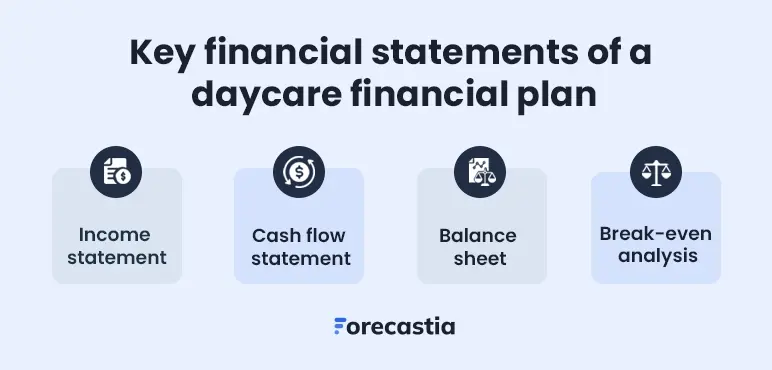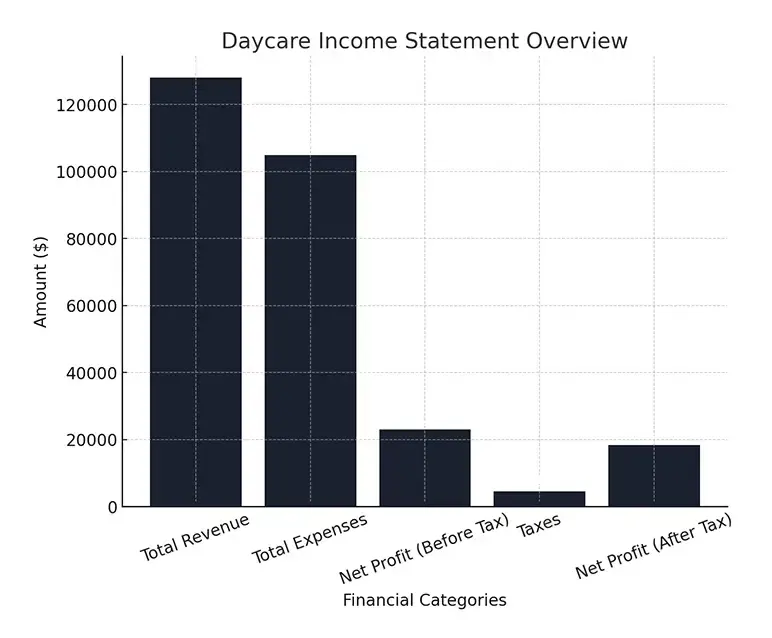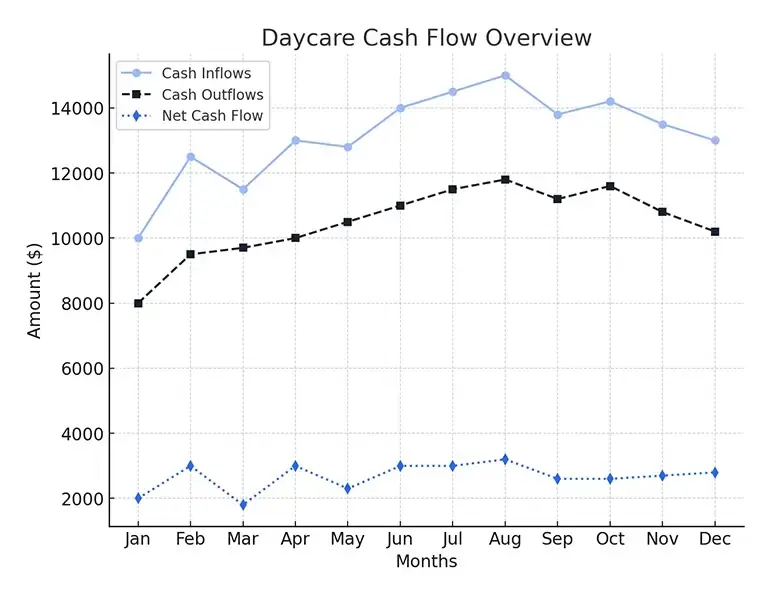Running a daycare involves more than just looking after children, it’s a business that requires a solid financial strategy to remain operational and thrive.
While love and patience help create a nurturing environment, effective budgeting and forecasting are essential for keeping your doors open.
Consider this your daycare’s financial guide monitoring revenue, expenses, and cash flow so you can concentrate on what truly matters.
In this guide, you’ll discover how to project income, control costs, and develop a financial plan that ensures your daycare operates smoothly.
Let’s work together to make your finances as reliable as your daily schedule.
How do you build daycare financial projections?
Creating realistic financial projections for your daycare involves thorough analysis and meticulous planning to comprehend its financial health and growth potential.
Here’s a step-by-step guide to help you build accurate and actionable projections while ensuring you factor in every detail:

1. Gather essential information
First, collect all the relevant key data that lays the groundwork for accurate financial projections.
This would include your daycare details like:
- Current operations
- Target demographics
- Historical financial performance
- And industry benchmarks.
Start with your enrollment data—look at daily and weekly attendance trends, peak drop-off and pick-up times, and how enrollment changes with seasons.
For a new daycare center, analyze the latest market trends, industry benchmarks, and local competitors to make educated estimates. Further, understand your customers inside out.
- Who are they?
- What do they look for in childcare?
- What are their scheduling preferences?
Then, track supply usage—monitor diaper stock, meal consumption, and learning materials to manage costs effectively.
Most importantly, remember to evaluate your daycare’s past performance data to understand what drives your business.
Try reviewing past revenues, costs, and profits to identify trends and areas to improve. Additionally, review how certain of your marketing initiatives, programs, or season activities affected your enrollment and cost of operation.
That’s how you'll have everything you need to create accurate and actionable financial projections.
2. Make rough pre-assumptions
Now, make some preliminary assumptions for your daycare’s financial projections based on gathered data. Such estimates will outline your business's revenues, expenses, and profitability levels.
Start by focusing on the basics: How much you’ll make in monthly sales, how much customers will spend on average, and what your operating costs might look like.
Use the understanding of past sales trends, industry benchmarks, and your own research. Even consider factors like seasonal enrollment shifts or upcoming program additions that could impact your numbers.
Here are a few key metrics to consider while making your assumptions:
- Revenue growth: Predict a percentage increase in sales, such as a 5% annual growth based on an expanding customer base or marketing efforts.
- Cost increases: Assume potential rises in supply costs or staff wage adjustments, such as a 10% increase in utilities during summer.
- Seasonality: Factor in enrollment spikes during back-to-school season or slower months like January after the holidays.
- Economic conditions: Account for inflation, rising wages, or other economic factors that may impact both costs and customer spending power.
Don’t aim for perfection—these are rough estimates to guide your planning that will evolve over time. So, revisit them periodically as actual data comes in.
3. Make revenue projections
Revenue projections are all about figuring out how much money your daycare might make.
To get started, think about a few simple things: How many children you can accommodate, how often slots open up, and how much parents typically pay for tuition.
Breaking it down step-by-step makes it easier to see your earning potential.
If your daycare business involves:
- Total Slots: 50
- Daily Sessions: 2
- Monthly Fee Per Child: $800
Revenue Calculation:
50 slots × 2 sessions × $800
= $80,000/month
But you’ll have to include in your choice things like vacation periods, schools closing, or other special events—these bring more enrollments and boost your income. Conversely, more relaxed times or midweeks may result in you receiving fewer drop-ins or part-time admissions.
Additionally, account for other ways to generate income. Services like extended care, weekend programs, tutoring, or hosting birthday parties can add a significant boost to your overall revenue.
By including these extra streams, you’ll get a more accurate picture of what your daycare business might earn.
Revenue projections aren’t merely a dry exercise of crunching numbers—they set realistic expectations while preparing for both the busy times and the quieter ones.
4. Calculate the Cost of Goods Sold (COGS)
The next step is to calculate your Cost of Goods Sold (COGS)—basically, the direct costs of providing childcare services. This includes meals, snacks, learning materials, diapers, and other supplies essential for daily care.
Here's an easy way to do your COGS calculation:

For example, if your daycare spends $20,000 a month on food, supplies, and materials to generate $80,000 in revenue, your COGS is $20,000.
Knowing your COGS will help you manage expenses, optimize resources, and boost profits.
5. Estimate operating costs
Next, describe the expected expenses incurred to operate your daycare center.
When assessing daycare operational costs, first list the fixed costs that stay the same every month, such as rent, insurance, and staff salaries.
Then, identify variable costs that change over time, including utilities, classroom supplies, food expenses, and marketing costs.
Lastly, sum up the fixed and variable costs to come up with your total operating costs.
If your daycare's monthly costs break down as follows:
- Rent: $12,000
- Utilities: $3,500
- Staff Wages: $35,000
- Other Expenses (Marketing, Supplies, Insurance): $4,500
Your total operating expenses would be $55,000/month.
Overall, by calculating your operating costs, you can manage your budget and know whether your revenues can cover all the expenses to leave room for profit.
6. Prepare financial statements
After estimating your daycare's revenue, COGS, and operating expenses, it’s time to draft clear financial statements. These documents are essential for illustrating your daycare business’s financial health and growth potential to prospective investors.
Here are the critical financial statements and reports that you should consider including in your plan:
- Income statement (profit and loss statement)
- Cash flow statement
- Balance sheet
- Break-even analysis
By including these financial statements, you’re disclosing your financial situation to potential investors so that they can make a well-informed investment decision.
We’ll go on to explain each of the financial components in greater detail below, giving you the facts that you'll use to create a sound financial strategy.
7. Prepare visual reports
Numbers alone aren't enough. Present your daycare’s financial data in a visually appealing and easily digestible format that readers can quickly understand and get valuable insights.
Using charts and graphs makes it easier to highlight your daycare center’s key aspects, including revenue trends, expenses, profit margins, and cash flow.
Don’t worry; it’s easy. Use simple bar charts, pie charts, and line graphs to make the data clear. Also, highlight patterns like seasonal sales changes or rising costs to help with planning.
This won’t only help analyze financial data but also enable you to communicate key metrics effectively to your team as well as investors.
8. Test assumptions, consider scenario analysis
Finally, take a step back and test the numbers to ensure your projections are more accurate. Try to run different scenarios (best- and worst-case) to see how changes impact your financial outcomes.
For instance, analyze what happens if supply costs increase by 15% or if enrollment drops during slower months like summer or post-holiday periods.
Considering these “what-if” situations helps you identify potential problems in business operations and come up with solutions in advance.
It even increases transparency and lets investors better understand your daycare’s future with different scenarios.
Overall, these test assumptions and sensitivity analyses will help you make strategic decisions and necessary adjustments to keep your daycare running smoothly.
Key financial statements of a daycare financial plan
A detailed daycare financial plan typically includes important financial documents like the income statement, cash flow statement, balance sheet, and break-even analysis.
These reports clearly describe your daycare's current monetary position and the overall financial strategy to achieve future goals.

Let's explore each statement in detail.
1) Income statement
The income statement is also known as the profit and loss statement. It gives you a solid understanding of your daycare’s revenue, expenses, gross margin, and net profit for a specific time.
It helps you see whether your business is making enough money to cover its costs and turn a profit.
The gross profit is what you get after subtracting the COGS from the total revenue. This shows how efficiently your daycare uses its resources.
Further, divide the gross profit by revenue and convert it into a percentage to determine the gross margin.
Then, reduce operating costs like rent, salary, and utility to get the EBITDA. Finally, subtract interest, taxes, depreciation, and amortization from the EBITDA to arrive at the net profit of your daycare—the figure that investors care about the most.
Here’s an example of a mid-sized daycare center’s income statement to demonstrate these calculations:
| Category | Amount ($) |
|---|---|
| Revenue | |
| Tuition Fees | $120,000 |
| Registration Fees | $5,000 |
| Miscellaneous Income | $3,000 |
| Total Revenue | $128,000 |
| Expenses | |
| Rent & Utilities | $30,000 |
| Salaries & Wages | $50,000 |
| Insurance | $5,000 |
| Supplies | $7,000 |
| Food & Snacks | $6,000 |
| Marketing & Advertising | $4,000 |
| Miscellaneous Expenses | $3,000 |
| Total Expenses | $105,000 |
| Net Profit (Before Tax) | $23,000 |
| Taxes (20%) | $4,600 |
| Net Profit (After Tax) | $18,400 |
Explanation:
An income statement shows your daycare’s financial performance over a period. It lists revenues (money earned) and expenses (costs incurred). The difference is net profit, indicating whether the daycare is profitable.
Revenue:
Primarily generated from tuition, enrollment fees, and other services.
Expenses:
Accounts for rent, employee wages, materials, and meals.
Profit Calculation:
By subtracting all costs and taxes, the overall net profit reflects what remains as earnings.
This sentence assists in assessing the daycare's financial health and making projections for future expansion.

2) Cash flow statement
A cash flow statement illustrates the flow of money in and out of your daycare over a specific timeframe. It helps you determine whether you have sufficient cash to meet your daily expenses.
Additionally, it’s useful for identifying potential cash shortages, particularly during slower months, and shows how much cash is generated from operations compared to sources like investments or loans.
To create one, you’ll need to account for cash from tuition and additional services, as well as expenses such as food, classroom supplies, staff wages, and other overhead costs like rent and utilities. It provides a clear picture of how much money your daycare is earning and spending during that period.
Here is an example:

That said, it’s a good illustration of how well your business is at generating cash. The precision of your projections in these aspects directly impacts the reliability of your cash flow.
So, be realistic with the assumptions you make in the cash flow statement. Use industry standards and consider market situations to ensure accuracy.
3) Balance sheet
A balance sheet gives a quick snapshot of your daycare’s financial position for a specific timeframe. It shows what the daycare owns, what it owes to others, and what’s left for you.
After all, it covers these key elements:
- Assets: Cash on hand, tuition fees receivable, and daycare property and equipment.
- Liabilities: Financial obligations like short-term debts and long-term loans.
- Equity: The leftover earnings once liabilities are subtracted from assets.
Ideally, it’s presented as, Assets = Liabilities + Equity.
| Category | Amount ($) |
|---|---|
| Assets | |
| Cash | $20,000 |
| Accounts Receivable | $5,000 |
| Equipment & Furniture | $30,000 |
| Building (if owned) | $100,000 |
| Other Assets | $7,000 |
| Total Assets | $162,000 |
| Liabilities | |
| Accounts Payable | $8,000 |
| Loans Payable | $40,000 |
| Other Liabilities | $5,000 |
| Total Liabilities | $53,000 |
| Owner’s Equity | |
| Retained Earnings | $20,000 |
| Owner’s Investment | $89,000 |
| Total Equity | $109,000 |
| Total Liabilities & Equity | $162,000 |
Investors pay close attention to the balance sheet because it shows them your daycare’s financial structure, return on investment (ROI), and overall stability.
It also provides an idea of the cash that is available to you, how the money is blocked, and what kind of solid business you are running.
4) Break-even analysis
We all know that profit is the all-time motive of all daycare owners. The real question is: When does the money start coming in?
A break-even analysis fits the bill at this stage. It shows exactly how much you’ll need to generate in revenue for all the costs to be recovered—no profit and no loss; just breaking even.
Let's take an example to see how it works.
For a daycare center:
- Fixed costs: $15,000 (including rent: $8,000, utilities: $2,000, and staff wages: $5,000)
- Variable costs: $25,000 (food, classroom supplies, activities)
- Revenue: $80,000Contribution Margin: ($80,000 - $25,000) ÷ $80,000 = 0.6875 (or 68.75%)
Break-even enrollment calculation: $15,000 ÷ 0.6875 = $21,818
This analysis shows exactly how much revenue is needed to reach the point where your total sales just cover your costs, causing no profit or loss.
In addition, this will give potential investors or lenders a fair idea of when your daycare would be profitable.
Download free daycare financial projections example
Creating a daycare financial plan from scratch seems overwhelming. After all, Excel sheets are tiring and endlessly long. But no worries! We’re here to help you with our free daycare financial plan sample.
It covers all the key components of a daycare's financial projection, such as sales forecast, P&L or income statement, balance sheet, cash flows, and break-even analysis, simplifying the entire financial planning process to help you get started.
Build accurate financial projections using Forecastia
That’s it! We’ve discussed almost everything about creating daycare financial projections in this guide. Now, it should be much easier for you to put that knowledge into action and start planning.
But if it still feels like a lot to handle, don’t worry; Forecastia is the only AI-powered financial forecasting tool you need to make the process simple and stress-free.
It’s specifically designed for businesses looking to build accurate financial projections, anticipate future cash flows, and analyze overall financial performance without spreadsheets!
Frequently Asked Questions
What are the key financial statements in a daycare financial plan?
A daycare financial plan includes three main financial statements:
- Income Statement
- Cash Flow Statement
- Balance Sheet
What are common operating expenses in a daycare financial plan?
Common daycare expenses include:
Fixed costs: Rent, utilities, staff wages, insurance, and licensing fees.
Variable costs: Food, classroom supplies, toys, learning materials, and marketing expenses.
How do I create financial projections for my daycare?
To create financial projections:
- Estimate revenue from tuition fees, part-time enrollments, and additional services.
- Calculate expenses, including rent, salaries, and supplies.
- Project COGS (Cost of Goods Sold) for food, materials, and activities.
- Forecast net profit by subtracting total costs from revenue.
How often should I update my daycare’s financial projections?
You should update projections at least quarterly or whenever there are major changes in enrollment, pricing, or operating costs. Regular updates help with budgeting and planning for growth.
How do I use the daycare financial projections template?
A daycare financial projections template simplifies planning by:
- Inputting your revenue streams (full-time, part-time enrollments, extra services).
- Entering fixed and variable costs.
- Automatically calculating profit, cash flow, and break-even points.
Use it to track financial health and adjust business strategies accordingly.

